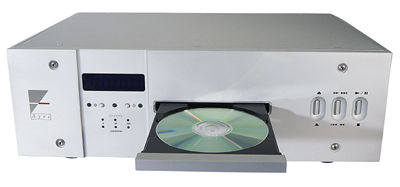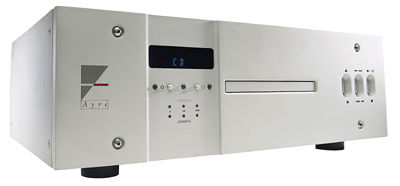Ayre D-1 DVD/CD player
That's exactly what Ayre Acoustics' Charlie Hansen thinks—minus the irony. He's betting that a small group of discerning videophiles will appreciate what he's done with the D-1, physically, aesthetically, and visually—and by "visually" I don't mean its looks, although, like all Ayre products, the D-1 has a smart-looking, sculpted, distinctively art deco-ish brushed-aluminum face.

Even if you can afford the D-1, you have to ask yourself, "Just how good can a DVD player be? Even if it's better, can it be that much better?" Those are the questions Hansen hopes this multi-option, updatable player answers, and in capital letters.
Your Options
The $5250 base-model D-1 is a digital audio transport only, for CD and the 24-bit/96kHz, 2-channel discs available from Chesky, Classic Records, Analogue Productions, and a few other audiophile labels. It must be used with an appropriate D/A converter, and in this configuration is strictly an audio-only device. It is not a DVD-Audio or DVD-Video player.
To watch DVDs, you'll need to add one of two options. The basic video option, for $750, includes interfaced composite, S-video, and component video outputs. The VR2 option, at $3250, exchanges the interlaced component outputs for progressive-scan. Your total DVD-player cost is thus $6000 or $8500, depending on which option you choose. If you do serious 2-channel music listening on your home-theater system and don't already own a top-rank D/A converter, you may also want to add the superb-sounding 2-channel analog audio option as well, which brings the grand total to $11,250. As a CD player equipped with those analog outputs, the D-1 was among the best I've heard. But although the review sample was the full-blown edition, for SGHT's purposes I've considered it as an $8500 DVD player.
What's Inside
The D-1 begins life as a Pioneer "manufacturing kit" consisting of a transport (drawer, laser, servo, disc motor, focusing mechanism, remote control, etc.), a fluorescent display, and the MPEG-decoder printed circuit board. The rest is modular, built by Ayre.
Before you get stuck right there, thinking "I'm paying how much for a modified Pioneer player?," consider that few, if any, manufacturers of high-end DVD players actually build their own transports. (Some make their own drawers, but because the drawer is not actually used during playback, it has no effect on performance.)
One of Ayre's primary design goals is the reduction of jitter due to power-supply problems and less-than-stellar clock circuitry. The Pioneer store-bought goods are assembled into an extremely rigid chassis. Ayre then adds its own proprietary video circuitry and low-jitter clocks. Canned oscillator chips are plentiful and cheap, but Hansen believes he achieves far better performance by building his own. I'll spare you the details, though a page could be devoted to these circuits' design. The D-1 also features a sophisticated outboard power supply separately grounded from and connected to the main chassis via a dual umbilical cord.

Hansen says he paid particular attention to grounding and circuit layout, both of which, he claims, can also affect jitter performance and other important video parameters. Four isolated grounds are used, because ground loops in audio-video systems are a "huge problem," he says. Possible video problems include 60Hz-induced rolling "hum bars" and high-frequency leakage currents from the switching power supplies used in almost all modern video monitors.
He also points to his research using a Sony television that had a typical ground leakage current of 2 milliamps at 100kHz, which can create faint "beat" or moiré patterns on the video display when allowed to loop through a system. Hansen claims video ground loops can induce a faint, high-frequency squarewave in the audio signal path that can seriously degrade the sound. He thus insists that the digital output of his player be balanced (you'll need an XLR-to-RCA adapter for most applications) using a high-quality, high-speed pulse transformer to avoid ground loops between the source and downstream components. The D-1 is said by the manufacturer to output a full-resolution 24-bit/96kHz signal.
Video Options
The base $750 video option uses 10-bit DACs, along with zero-feedback video amplifiers and power-supply regulators for all outputs. I doubt many SGHT readers would consider spending $6000 on a non-progressive-scan DVD player [see sidebar for further thoughts on this—TJN], so let's get right to where Hansen devoted the most attention—the VR2 option. The composite and S-video outputs here are identical to the standard video option. However, the progressive output remains a ground-up design. He chose the DVDO chip, which he thinks offers the highest-quality glitch-free performance, thanks in part to its inclusion of 3:2 pulldown.
The digital signal is sent raw from the MPEG board to the DVDO chip and an auxiliary 8MB of RAM microprocessor. The chip stores four fields of memory at a time, allowing for correction of sequencing errors and other problems.
A de-interlaced 480-line progressive-scan video signal exiting the DVDO chip goes to three 2x oversampling digital filters (one for each leg of the component signal), which are used for the same reason as in audio: to get the frequency well above the signal range so that ringing brick-wall analog filters aren't needed. The 54MHz video information then goes to three pairs of individual, differential 14-bit video digital-to-analog converters (DACs), each powered by separately regulated lines from the power supply. The differential DAC output is routed to proprietary differential current-to-voltage circuitry. The analog video circuitry is zero-feedback and direct-coupled, ensuring a rock-solid black level, according to designer Hansen.
Most DVD players feature 10-bit DACs for what is an 8-bit system. The progressive output of the VR2 uses 14-bit DACs because, according to Hansen, 10 bits are simply not enough to resolve all 8 bits accurately: there is an additional bit required to generate the sync pulse, and every DAC is good only to ±1-2 LSB (least significant bits). So, Hansen charges, a 10-bit DAC can have "substantial errors in the LSB." The Ayre's video DACs, designed for satellite communications and other non-consumer-electronics applications, cost $750 retail—more than most DVD players!













































